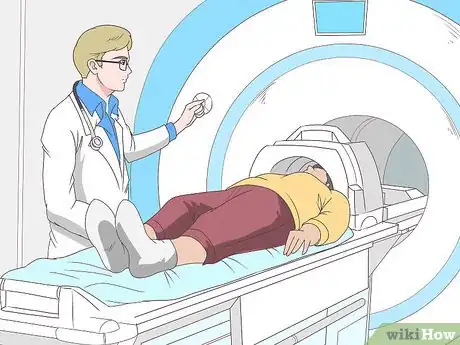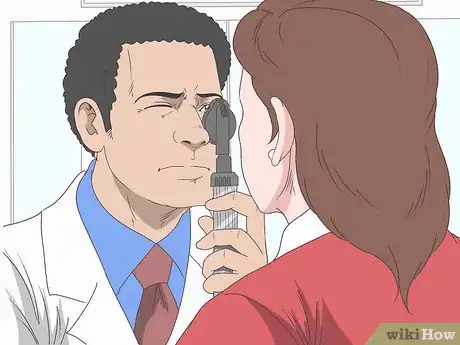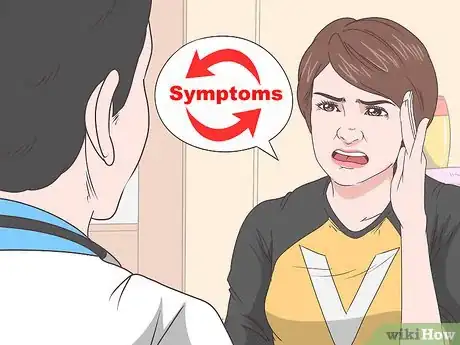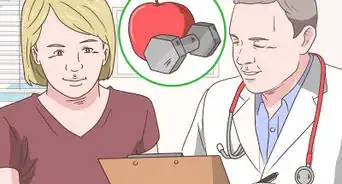This article was co-authored by Marsha Durkin, RN. Marsha Durkin is a Registered Nurse and Laboratory Information Specialist for Mercy Hospital and Medical Center in Illinois. She received her Associates Degree in Nursing from Olney Central College in 1987.
There are 9 references cited in this article, which can be found at the bottom of the page.
This article has been viewed 9,633 times.
Pseudotumor cerebri, also known as intracranial hypertension, is a rare condition in which the pressure in the fluid around the brain increases. This pressure can create a variety of symptoms, including headaches and trouble seeing. The good news is that pseudotumor cerebri can often be treated with medication. However, if the medication doesn't work, surgery will be necessary to lower the pressure around the brain.[1]
Steps
Diagnosing Pseudotumor Cerebri
-
1Notice the symptoms of pseudotumor cerebri. Pseudotumor cerebri got its name because its symptoms mimic those created by actual brain tumors. The symptoms associated with this condition may include:[2]
- Very high blood pressure, alongside other symptoms
- Headache, usually dull and starting between the eyes
- Episodes of blurred vision or blindness
- Ringing in the ears
- Pain in the neck, back, or shoulders
- Nausea or vomiting
-
2Go to your doctor for assessment. If you notice the symptoms of pseudotumor cerebri, it is important to get this condition treated by a medical professional as soon as possible. If it goes untreated, it can cause permanent vision loss, in addition to painful and debilitating symptoms. Call your doctor and schedule an appointment to be seen as soon as possible.[3]
- Tell the person you talk to at your doctor's office what your symptoms are and that you would like to be seen as soon as possible.
Advertisement -
3Get a physical exam and testing done to verify a diagnosis. When you are at your doctor's office they will typically begin by asking your about your symptoms and giving you a physical exam. They will need to rule out a variety of possible causes for your symptoms before giving you a definitive diagnosis. To help them assess your condition, they may also run diagnostic tests, which will likely include:[4]
Taking Medication
-
1Take a carbonic anhydrase inhibitor. It is likely that your doctor's first line of treatment for pseudotumor cerebri will be to prescribe you medication. This class of medication, including acetazolamide and furosemide, can help reduce the pressure around your brain.[5]
- In most cases, you will be prescribed between 500 and 1000 mg per day.
- Furosemide is a water pill, so you usually have to take a large dosage for it to lower the pressure.
-
2Begin corticosteroid therapy. This medication can be very effective for reducing vision loss in patients because it is an anti-inflammatory. If you have a serious case of pseudotumor cerebri, your doctor will likely prescribe you a high dose of 60 to 100 mg per day to reduce inflammation right away.[6]
- Your doctor will likely give you injections of corticosteroids, which helps the medication quickly enter your system.
- Corticosteriods are not a long-term solution for patients with pseudotumor cerebri. Long-term use can cause a variety of side effects, including weight gain, fluid retention, osteoporosis, hypertension, and a variety of other serious health problems.[7]
-
3Take pain relievers. One of the side effects that can be debilitating for patients with pseudotumor cerebri is headaches. In most cases you can minimize these headaches with simple over-the-counter pain relievers, such as ibuprofen. However, if these common pain relievers are not effective, talk to your doctor about being prescribed a stronger pain reliever.[8]
- The most effective prescription pain relievers are often those used for migraines, including amitriptyline, propranolol, topiramate, or other prophylaxis agents.
Having Medical Procedures Done
-
1Discuss medical procedures that might be helpful with your doctor. If medications are not treating your condition effectively, then you may need surgical treatment. Have a conversation with your doctor that includes what the doctor thinks will be most successful for your specific case, the risks involved with different procedures, and what the potential benefits of each procedure are.[9]
- The type of procedures that are suggested will vary depending on the severity and type of your symptoms.
-
2Have optic nerve sheath fenestration done. This is an ophthalmic surgical procedure in which slits are cut in the area around the optic nerve, allow excess fluid to be released. This allows the pressure to be reduced on the optic nerve, reducing vision loss.[10]
- This is typically a very successful procedure that can improve vision temporarily. However, it is not a permanent solution and vision problems return in about a third of patients.
-
3Have a drain implanted. If your condition is severe and debilitating, the doctor may suggest putting in a permanent shunt. An implanted shunt will continually drain fluid that is impacting the optic nerve.[11]
- Having a shunt requires continual care to keep it clear and clean.
- It's normal for shunts to fail over time. Many patients have their shunt replaced after it fails, sometimes more than once.
Caring For Your Condition
-
1Make lifestyle changes. There are a variety of things your doctor will ask you to do to minimize your condition. Have a discussion with your doctor about what you can do to help reduce your symptoms and the condition overall. Helpful changes you can make include:[12]
- Lose weight.
- Limit your fluid intake.
- Minimize the salt in your diet.
-
2Get your vision checked regularly. Once you have been diagnosed with pseudotumor cerebri it is important to keep an eye on any vision changes that are occurring, so that any additional vision loss can be prevented. How often you get your eyes checked depends on the severity of your condition.[13]
- For example, if your vision has been severely impacted, you may need weekly checkups until the condition subsides.
- If your symptoms have subsided, your doctor may suggest coming in for a checkup every few months.
-
3Tell your doctor if symptoms return. Because pseudotumor cerebri can come back, you should continue to be vigilant about looking for possible symptoms to return. If you suspect you are having symptoms again, even if they are minor, you should get medical care right away.[14]
-
4Alert your doctor if side effects occur from medication. If you are taking medication it's important to know the possible side effects you may experience. With pseudotumor cerebri, the medication that is most likely to give you the side effects is carbonic anhydrase inhibitor. Notify your doctor if you have any of these side effects and they may be able to adjust your medication:[15]
- Paresthesia, which is a sensation of burning or itching on the skin.
- Dysgeusia, which is a foul or metallic taste in the mouth.
- Vomiting.
- Diarrhea.
- Nausea.
- Fatigue.
References
- ↑ https://www.ninds.nih.gov/health-information/disorders/pseudotumor-cerebri
- ↑ https://www.hopkinsmedicine.org/health/conditions-and-diseases/pseudotumor-cerebri
- ↑ https://my.clevelandclinic.org/health/articles/6097-pseudotumor-cerebri
- ↑ https://my.clevelandclinic.org/health/articles/6097-pseudotumor-cerebri#diagnosis-and-tests
- ↑ https://emedicine.medscape.com/article/1214410-treatment#showall
- ↑ https://emedicine.medscape.com/article/1214410-treatment#showall
- ↑ https://my.clevelandclinic.org/health/drugs/4812-corticosteroids
- ↑ https://www.drugs.com/cg/idiopathic-intracranial-hypertension-discharge-care.html
- ↑ https://www.uptodate.com/contents/idiopathic-intracranial-hypertension-pseudotumor-cerebri-prognosis-and-treatment
- ↑ https://www.uptodate.com/contents/idiopathic-intracranial-hypertension-pseudotumor-cerebri-prognosis-and-treatment
- ↑ https://www.uptodate.com/contents/idiopathic-intracranial-hypertension-pseudotumor-cerebri-prognosis-and-treatment
- ↑ https://www.hopkinsmedicine.org/health/conditions-and-diseases/pseudotumor-cerebri
- ↑ https://www.ninds.nih.gov/health-information/disorders/pseudotumor-cerebri
- ↑ https://medlineplus.gov/ency/article/000351.htm
- ↑ https://emedicine.medscape.com/article/1214410-treatment#showall










































































Medical Disclaimer
The content of this article is not intended to be a substitute for professional medical advice, examination, diagnosis, or treatment. You should always contact your doctor or other qualified healthcare professional before starting, changing, or stopping any kind of health treatment.
Read More...